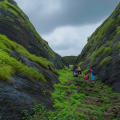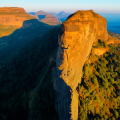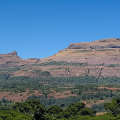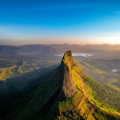There’s something magical about trekking in the monsoon the mountains come alive, the clouds dance low, and nature wraps you in its raw beauty. This time we set off to explore one of Maharashtra’s underrated yet breathtaking destinations Korigad Fort.
Located near Pawna Lake and accessible through routes like Mulshi, Peth Shahapur, and Ambavne, Korigad offers a blend of history, spirituality, and lush landscapes, making it a perfect monsoon trek for beginners and nature lovers alike.
Korigad Fort – A Glimpse into History
Korigad Fort, believed to be built around the 1500s, was later captured by Chhatrapati Shivaji Maharaj in 1657, becoming a strategic part of the Maratha Empire. Even today, the fort’s strong stone walls (Tat bandi) and entrance gates like Ganesh Dwar echo tales of resilience and power. It stands at around 3,050 feet above sea level and guards over the valleys of Lonavala and Pawna with dignity.
What’s fascinating is that despite centuries gone by, the fortification, temples, and lakes atop Korigad still remain intact and full of character.
From Mulshi to the Fort Base
We began our journey through the Mulshi route, soaking in mesmerizing views of rivers swollen with monsoon waters. As we moved closer to Pawna Dam, the landscapes transformed small waterfalls tumbled down hills, clouds floated across valleys, and the air carried the scent of fresh earth.
Reaching the base village of Peth Shahapur, the fort revealed itself through a foggy, dramatic view. With rain-kissed stones and mist swirling around, Korigad looked like a dream waiting to be explored.
Monsoon Magic Unfolds
The trek offers two main routes one from Peth Shahapur and another from Ambavne. We took the Peth Shahapur route, which is a slightly steeper path but filled with sights that make every step worth it.
As we climbed the stone steps, waterfalls greeted us on either side. The path was scenic, with dense greenery around and the sounds of monsoon insects and birds.
Soon, we passed a Ganpati temple nestled into the trail, along with cave-like rooms carved into the rocks some even filled with water due to the rains. These give you a sense of how soldiers might have rested during ancient times.
Reaching the third stage of the fort felt like stepping into a different world.
Fort Views & Lakeside Vibes
The Ganesh Dwar the first gate of Korigad Fort stands tall, leading you into the inner sanctum. Walking ahead, the Tat bandi offered panoramic views of the valley below.
Each stone tells a story of battles fought, of Maratha warriors standing strong, and of the fort’s enduring spirit through centuries of change.
The crown jewel of Korigad is its two serene lakes at the top. Surrounded by grass and fog, these lakes create a postcard-perfect reflection of the skies above.
Nearby stands the Koraidevi Temple, dedicated to the fort’s presiding goddess. With old stone structures and an aura of peace, this spot is ideal for a quick rest and spiritual recharge.
Exploring further, we were awestruck by the large central lake on the fort a perfect example of ancient water conservation techniques.
As we descended, the rain began to pour gently and winds blew stronger, adding thrill and freshness to the journey. Korigad had given us more than just adventure it gifted us peace, history, and unforgettable views.
This fort is a true monsoon treasure easy to access, moderate in trek difficulty, and rich in culture and nature.
Final Thoughts
Whether you’re a trekker, a history lover, or someone chasing monsoon chills, Korigad Fort Trek will surprise you with its simplicity and charm. With lush surroundings, ancient marvels, and calming lakes, it’s the kind of destination that stays with you long after you leave.
Discover lesser-known trails and panoramic views in the Sahyadris. A must-read if you love untouched nature and solitude.
Also Read




